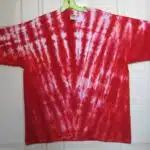In the world of clothing alterations, resizing a shirt can be a daunting task. Whether you’ve purchased a shirt that’s just too big or have lost weight and need to adjust your wardrobe accordingly, knowing how to shrink a shirt properly is crucial in achieving the perfect fit. While many people opt for taking their garments to a professional tailor, learning how to do it yourself can save both time and money.
Shrinking a shirt involves more than just throwing it into the dryer on high heat. Different fabrics and materials require different methods of shrinking, and improper techniques can result in irreversible damage. As an alteration expert, I have seen countless shirts ruined by botched attempts at shrinking. In this article, I will share my knowledge and experience on how to properly shrink a shirt without compromising its quality or structure. By mastering these techniques, you’ll be able to confidently resize any shirt in your wardrobe and enjoy a comfortable and flattering fit all year round.
Understanding Fabric Types
Understanding Fiber Properties
To properly shrink a shirt, it is essential to understand the properties of the fabric. The most common fibers used in shirts are cotton, polyester, and blends of these two. Cotton is a natural fiber that is highly absorbent and breathable, making it comfortable to wear in warm weather. On the other hand, polyester is a synthetic fiber that is resistant to wrinkles and shrinking. Blended fabrics combine the best features of both fibers.
The importance of fabric care cannot be overstated when attempting to shrink a shirt. Different fibers require different care techniques to maintain their quality and prevent damage. For example, cotton should be washed in cold water to avoid shrinking and fading, while polyester can withstand higher temperatures without damage. It is also important to follow the manufacturer’s care instructions and avoid using harsh detergents or bleach.
Understanding the properties of your shirt’s fabric and proper fabric care are crucial steps in preparing for successful shirt shrinking. By taking these precautions, you can ensure that your shirt will not only shrink appropriately but also maintain its quality and longevity over time.
Transitioning into Preparing Your Shirt for Shrinking: Now that you have an understanding of your shirt’s fiber properties and proper fabric care techniques let’s move on to preparing your shirt for shrinking.
Preparing Your Shirt For Shrinking
Like a sculptor creating a masterpiece, preparing your shirt for shrinking requires careful consideration and precise movements. Before applying any shrinking techniques, it’s important to understand the fabric care label attached to your shirt. Some fabrics can withstand high heat and agitation, while others require gentler treatment. Once you have identified the fabric type, you can move on to selecting the right technique for achieving your desired size.
To achieve optimal results, follow these tips when preparing your shirt for shrinking:
- Start with a clean garment: wash your shirt according to its care label instructions before attempting to shrink it.
- Use hot water: hot water is an important component of most shrinking techniques. It helps relax the fibers in the fabric and make them more susceptible to shrinking.
- Avoid using bleach or fabric softeners: both substances can damage the fibers in your shirt and prevent it from shrinking properly.
When preparing your shirt for shrinking, it’s important to pay attention to every detail. A small mistake can ruin all of your hard work and leave you with an ill-fitting garment. By following these simple tips, you’ll be well on your way to achieving a perfectly sized shirt that looks great and feels comfortable.
As important as it is to prepare your shirt for shrinking correctly, washing it correctly is equally crucial. In the next section, we will discuss step-by-step instructions on how to properly wash a shrunken shirt without causing further damage or losing its shape.
Washing Your Shirt Correctly
Understanding different fabric types is crucial in washing your shirt correctly. Each fabric type requires specific care to avoid shrinkage, fading, or damage. Cotton, for instance, is a popular and versatile material that can withstand high temperatures and frequent washing. However, it tends to shrink when exposed to hot water or dried on high heat. On the other hand, silk is more delicate and requires gentle washing with cold water and mild detergent.
To ensure the longevity of your shirt, it’s essential to follow the best washing practices. First, separate light-colored shirts from dark ones to prevent color bleeding. Then, turn your shirt inside out before placing it in the washing machine. This helps protect the outer layer of your shirt from rubbing against other clothes or surfaces during the wash cycle. Use a gentle cycle setting and mild detergent to avoid damaging the fabric fibers.
Properly washing your shirt sets you up for successful shrinkage control later on in the drying process. So if you want to shrink your shirt effectively without causing damage or uneven shrinking, you should take care when washing it first. In the next section, we will discuss how drying your shirt on high heat plays a crucial role in achieving desired results while maintaining its quality and shape.
Drying Your Shirt On High Heat
After washing your shirt correctly, it’s now time to dry it. One method that people often use is drying their shirts on high heat. However, this method can cause damage to your shirt and may not be the best idea if you’re trying to shrink it.
Benefits of drying your shirt on high heat include faster drying time and reduced wrinkles. However, there are also risks involved with this method. High heat can cause shrinkage, fading, and damage to the fabric of your shirt. It’s important to weigh the pros and cons before deciding whether or not to use this method.
Alternative methods for shrinking a shirt include air-drying or using a dryer on low heat. Air-drying avoids any potential damage caused by high heat and can help preserve the quality of your shirt. On the other hand, using a dryer on low heat can still provide some benefits while reducing the risks associated with high heat drying. Ultimately, it’s up to you to decide which method works best for you and your shirt.
When using hot water for cotton shirts, it’s important to remember that hot water can also cause shrinkage. However, if you’re specifically trying to shrink a cotton shirt, hot water may be an effective option along with air-drying or low-heat drying in the dryer. Keep in mind that this method should only be used for cotton shirts as other fabrics may not react well to hot water treatment. By understanding the benefits and risks of various methods for shrinking shirts, you’ll be able to choose the best approach for your needs while preserving the quality of your clothing.
Using Hot Water For Cotton Shirts
When it comes to shrinking a cotton shirt, hot water is one of the most effective methods. However, it’s important to note that not all cotton shirts are created equal. Pre shrunk cotton shirts have already undergone a washing process that prevents them from shrinking further. On the other hand, non shrunk cotton shirts can shrink up to 20% in size.
If you’re looking for an extra boost in shrinking your cotton shirt, adding vinegar to the hot water can help. The acidity in vinegar breaks down the fibers in the fabric, causing them to tighten and shrink. Simply add half a cup of white vinegar to your hot water wash cycle and let your shirt soak for 30 minutes before rinsing.
It’s also important to consider the quality of the cotton shirt before attempting any shrinking methods. Higher quality fabrics may not shrink as much or at all, while lower quality fabrics may shrink significantly even with pre-shrinking. With these factors in mind, using hot water and vinegar can be an effective way to shrink a cotton shirt and achieve a better fit.
Moving forward, if you’re dealing with wool shirts instead of cotton ones, using boiling water may not be the best option due to its delicate nature. Instead, there are alternative methods that can be used to properly care for wool garments without causing damage or excessive shrinking.
Using Boiling Water For Wool Shirts
When it comes to shrinking wool shirts, using boiling water may seem like a quick and easy solution. However, this method can cause irreparable damage to the fabric and leave you with a shirt that is too small or misshapen. Instead, consider alternative methods for shrinking your wool shirt.
One alternative option is to use hot water in combination with agitation. This involves soaking the shirt in hot water for about 30 minutes and then agitating it by hand or using a washing machine on a gentle cycle. Keep in mind that this method may only result in a slight shrinkage of the shirt and should be approached with caution.
Another alternative method is to use steam. This can be achieved through steaming the shirt with an iron or using a handheld steamer. Simply place the shirt on a hanger and hold the iron or steamer about 6 inches away from the fabric, moving it back and forth until the entire shirt has been steamed. This method will not only shrink the shirt but also remove any wrinkles, leaving it looking fresh and new.
When caring for wool fabrics, it’s important to always read and follow care instructions carefully. Avoid exposing wool garments to high heat as this can cause them to shrink or become damaged beyond repair. By understanding different methods for shrinking wool shirts and practicing proper wool fabric care, you’ll be able to keep your clothing looking great for years to come.
Transition sentence: Now that we’ve covered how to use steam to shrink your wool shirt, let’s discuss another effective alternative – using a steam iron.
Using A Steam Iron
After boiling wool shirts, it is important to be mindful of the next step in the shrinking process. Ironing techniques can help reduce the size of a shirt without causing any damage or shrinkage. However, choosing the right iron is crucial in achieving the desired results.
Firstly, consider the type of fabric and its heat tolerance before selecting an iron. For instance, silk and linen are more delicate, requiring low to medium heat settings. On the other hand, cotton and polyester are more durable and can withstand higher temperatures. Secondly, choose an iron that has steam capabilities as this will aid in eliminating wrinkles and easing the shrinking process.
When using an iron for shrinking a shirt, there are several techniques that can be applied to achieve optimal results. These include:
- Dampening the shirt before ironing: This helps to activate steam when pressing on the garment.
- Using a pressing cloth: This protects delicate fabrics from direct contact with high heat.
- Ironing inside-out: This helps to prevent any damage to prints or decorations on the shirt.
- Focusing on problem areas: Pay attention to areas such as sleeves or collars that may require extra attention.
- Allowing time for cooling: Once done ironing, allow enough time for the shirt to cool off before handling it.
Using these techniques with proper selection of an appropriate iron will result in a perfectly shrunk shirt. Next up is air drying which can be achieved by using a clothesline or hanging rack.
Using A Clothesline To Air Dry
- When using a clothesline to air dry, the first step is to hang the clothing article on the line to ensure it is evenly distributed.
- Depending on the type of clothing, the length of the clothesline should generally be sufficient to allow for a reasonable amount of air circulation.
- Wind is an important factor to consider when hanging clothing on a clothesline, as it can help to speed up the drying process.
- When selecting a spot for the clothesline, it is important to consider the amount of sunlight that will reach the clothing, as this can affect the rate of drying.
- If the clothing is not dried properly on the clothesline, it has the potential to shrink during the drying process.
- Therefore, it is essential to monitor the drying process and make adjustments as needed to ensure the clothing does not shrink.
Hanging Clothes
As a clothing alteration expert, maximizing space is crucial in hanging clothes. When using a clothesline to air dry your clothes, it’s important to choose the right hangers to ensure that your clothing items are not stretched out of shape. A good rule of thumb in hanging clothes is to hang them upside down, especially shirts and blouses.
Choosing the right hangers is essential in preventing wrinkles and creases on your clothes. For shirts, use hangers with broad shoulders as they help maintain the shape of the garment. Also, avoid using wire hangers as they tend to leave marks on your clothes. Instead, opt for plastic or wooden hangers which are sturdier and more reliable.
When hanging shirts or blouses, turn them inside out before hanging them up to prevent fading due to exposure to sunlight. Hanging clothes upside down also makes it easier for you to iron out any wrinkles that may have formed during the drying process. Follow these tips when hanging your clothes on a clothesline and you’ll be sure to have wrinkle-free and well-shaped garments every time.
By following these simple steps of maximizing space and choosing the right hangers when hanging your clothes on a clothesline, you’ll be able to save time by avoiding unnecessary ironing or steaming. Plus, you’ll also be doing your part in helping the environment by reducing energy consumption from using a dryer. So go ahead and try these tips today!
Clothesline Length
When it comes to using a clothesline to air dry your clothes, choosing the right clothesline is just as important as selecting the right hangers. There are various types of clotheslines available in the market today, ranging from retractable lines to stationary poles. Choosing the right one for your needs depends on several factors such as space availability and personal preference.
Before installing a clothesline, it’s essential to determine its length and adjust it accordingly. The ideal height for a clothesline is about six feet above the ground or at waist level. However, this may vary depending on your height and comfort level. To adjust the height of your clothesline, you can use adjustable hooks or pulleys that allow you to raise or lower the line as needed.
Another factor to consider when adjusting your clothesline’s height is the type of clothing you’ll be hanging. Longer items like pants or sheets require more space between lines, while shorter items like shirts can be hung closer together. Properly adjusting the height and spacing of your clothesline ensures that your garments dry quickly and efficiently without touching each other, preventing wrinkles and creases from forming.
Wind And Sunlight
When it comes to using a clothesline to air dry your clothes, there are many factors to consider. One of these factors is the use of wind and sunlight to shrink clothes. The combination of wind and sunlight is an excellent way to dry your garments naturally. The wind helps circulate the air around your clothing, while sunlight helps remove any lingering moisture.
Using wind and sunlight to shrink clothes has many benefits. Not only is it eco-friendly, but it can also save you money on energy bills. Additionally, hanging clothes outside can give them a fresh scent that cannot be replicated with artificial fragrances. However, there are also some drawbacks to this method. For example, strong winds may cause your clothing to fly away or become tangled in the line.
To make sure that using wind and sunlight to shrink clothes works effectively for you, consider the weather conditions before hanging out your garments. You will want to avoid drying your items on a rainy day or when there is high humidity in the air. It’s also important to remember that certain fabrics may not fare well in direct sunlight and should be hung in the shade instead. By following these tips, you can ensure that using wind and sunlight as part of your clothesline routine will be beneficial for both you and your clothing.
Using A Hairdryer To Spot Shrink
Imagine you have a shirt that fits great in most places, but the sleeves are just a bit too long. You might feel like you need to take it to a tailor for alteration, but there is another way. Spot shrinking using a hairdryer can be an effective method for taking care of this problem. This technique is especially useful if you only need to shrink one part of your shirt rather than the entire garment.
To use a hairdryer for spot shrinking, you’ll need to start with a clean shirt. Then, wet the area that needs to be shrunk and place it on a flat surface. Next, use a diffuser attachment on your hairdryer to apply heat directly to the damp area. The diffuser will help distribute heat evenly and avoid damage from concentrated airflow.
It’s important not to overheat or over-shrink your shirt when using this method. Be patient and check regularly that the sleeve length has reduced enough by trying it on or measuring it against another shirt. Remember that you can always repeat the process if necessary, but once you’ve over-shrunk your garment, there’s no going back. In our next section, we’ll discuss some tips for avoiding this common mistake and ensuring that your shirts fit perfectly every time.
Avoiding Over-Shrinking
Before attempting to shrink a shirt, it is important to take pre washing precautions. This means reading the care label and following the instructions carefully. Some shirts may not be suitable for shrinking, while others may require specific temperature settings or hand washing. Failure to follow instructions can result in irreversible damage to the fabric.
Once you have determined that the shirt can be safely shrunk, proper measuring techniques are essential for achieving desired results. Measuring the shirt before and after washing will ensure you know how much shrinkage has occurred and if further adjustments are necessary. It is also important to consider the type of fabric, as some materials such as cotton tend to shrink more than others.
Avoid over-shrinking by monitoring the shirt during the shrinking process. Check periodically on the size and fit of the shirt until it has reached your desired level of shrinkage. Remember that once a shirt has been over-shrunk, it cannot be undone. By taking these precautions and using proper techniques, you can successfully shrink your shirts without damaging them.
Transition: Now that you know how to properly shrink a shirt without over-shrinking it, let’s discuss how to deal with stains and odors on clothing.
Dealing With Stains And Odors
After avoiding over-shrinking, the next step in altering a shirt is dealing with stains and odors. This is especially important if you are working with a shirt that has been previously worn or stored for a long time. Removing tough stains can be a challenging task, but it is possible with the right techniques.
One effective way to remove tough stains from a shirt is by using a stain remover solution. Apply the solution directly onto the stained area and let it sit for a few minutes before washing the shirt. For persistent stains, you can try using a mixture of baking soda and vinegar or hydrogen peroxide. Simply mix equal parts of each substance together and apply it onto the stain before washing.
Eliminating persistent odors from a shirt can also be achieved through various methods. One option is to soak the shirt in a mixture of water and white vinegar for at least 30 minutes before washing it. Another option is to use baking soda as an odor neutralizer by sprinkling it on the shirt before washing and letting it sit for about 15 minutes. With these tips, you can effectively deal with stains and odors to give your shirt a fresh start.
To achieve an even better fit after shrinking your shirt, repeat the process if necessary. Depending on how much shrinkage you desire, you may need to repeat this process multiple times until you get your desired result. By following these tips and taking your time during this alteration process, you can achieve excellent results that will make your shirt look like it was professionally tailored just for you.
Repeating The Process For A Better Fit
Now that you have successfully shrunk your shirt, it’s time to focus on adjusting the proportions for a better fit. The shirt may have shrunk uniformly, but it’s still possible that some areas may be too loose or tight. For instance, the sleeves may be too long or short, or the shoulders may not sit well on your frame. To address these issues, you can use standard tailoring techniques such as hemming and darting.
In addition to adjusting proportions, you may also need to repeat the shrinking process if the shirt is still too loose. However, before doing so, ensure that you’ve exhausted other alternatives such as altering the seams or taking in the excess fabric. If repeating the process is necessary, use re-shrinking techniques such as washing in hot water and drying on high heat. Remember to check the care label first and avoid using these methods on delicate fabrics.
By following these steps, you should end up with a shirt that fits perfectly without feeling too constricting or baggy. However, it’s important to note that prevention is always better than cure when it comes to clothing alterations. In the next section, we’ll discuss tips for preventing future shrinking so that you don’t have to go through this process again anytime soon.
Tips For Preventing Future Shrinking
Preventing future shrinkage is an essential part of fabric care. If you want your clothes to last longer, it’s crucial to take measures that will keep them from shrinking. Here are some tips for preventing future shrinkage:
Firstly, always read the care label on the clothing before washing it. The label provides valuable information on how to care for the garment and will give you instructions on whether or not it can be machine washed or dry cleaned. Following these instructions will help prevent shrinkage.
Secondly, avoid using hot water when washing clothes. Hot water causes fabrics to shrink faster than cold water because it breaks down the fibers in the fabric. Instead, use cold or warm water when washing your clothes.
Lastly, avoid drying your clothes on high heat settings. High heat can cause fabrics to shrink rapidly. To prevent this from happening, air dry your clothes by hanging them up in a well-ventilated area. If you must use a dryer, use a low heat setting and remove the clothes as soon as they are dry.
By following these fabric care tips, you can prevent future shrinkage and ensure that your clothes last longer. In the next section, we’ll discuss common mistakes people make when trying to prevent their clothing from shrinking so that you can avoid them altogether.
Common Mistakes To Avoid
One common mistake people make when attempting to shrink a shirt is not testing the fabric beforehand. Different fabrics have different tolerances for heat and water, and failing to take this into account can result in irreversible damage to your garment. To avoid this, always test a small section of the fabric first by submerging it in hot water for a few minutes. If the fabric appears to be okay, you can proceed with the shrinking process.
Another mistake people make when shrinking shirts is using too high heat. This can cause the fibers in your shirt to break down and lose their shape, resulting in an ill-fitting garment that cannot be worn again. To prevent this from happening, always use low heat settings when drying or ironing your shirt. Additionally, be sure to measure your shirt before attempting to shrink it so that you can track its progress and ensure that it is not being damaged in the process.
To ensure success when shrinking a shirt, it’s also important to stretch it out before beginning the process. This helps to loosen up the fibers and make them more receptive to contracting during the shrinking process. You can do this by gently pulling on different parts of the shirt while damp or wet, being careful not to tear or rip any seams or buttons. By following these tips and avoiding common mistakes, you can successfully shrink your shirt without damaging it beyond repair.
In some cases, however, shrinking a shirt may be too complicated or risky for someone who is not experienced in clothing alterations. When in doubt, seeking professional help may be necessary to avoid ruining your favorite garments. A skilled tailor or seamstress will have extensive knowledge of fabrics and will know how best to approach shrinking your specific garment without causing any damage. Don’t hesitate to reach out for assistance if you are unsure about how to proceed with shrinking your shirt – it could save you time, money, and heartache in the long run!
Seeking Professional Help When In Doubt
If you are unsure about how to shrink a shirt, seeking professional help may be the best option for you. There are several benefits to consulting with a clothing alteration expert, including receiving personalized advice and guidance on the appropriate methods to use. Professionals have vast knowledge of fabric types, which is essential in determining the best course of action for shrinking your shirt without damaging it.
However, there are also risks associated with attempting to shrink a shirt without proper knowledge or experience. If done incorrectly, you could potentially damage the fabric or alter the garment’s overall shape and fit. Additionally, some fabrics may not respond well to certain shrinking methods, resulting in permanent damage.
In these situations, it is always better to be safe than sorry and seek the help of an experienced professional. By doing so, you can ensure that your shirt will be successfully shrunk without any negative consequences. Ultimately, investing in professional assistance can save you both time and money by avoiding costly mistakes and prolonging the life of your garment.
Conclusion
Understanding the fabric type of your shirt is crucial before attempting to shrink it. Cotton and other natural fibers shrink easily, while synthetic fabrics like polyester are more difficult to shrink. Preparing your garment by removing any stains or dirt is essential for an even shrinking process. Washing and drying your shirt on high heat will result in the most significant amount of shrinking. For cotton shirts, using hot water in the washing cycle is also recommended.
Repeating the shrinking process may be necessary for a better fit, but be cautious not to over-shrink your garment. Always avoid common mistakes like using too much detergent or folding a wet shirt immediately after drying. Seeking professional help when in doubt is always advised. With these tips and techniques, you can successfully shrink your shirt to achieve a better fit that complements your personal style. As a clothing alteration expert, I recommend following these steps carefully for optimal results and preventing future shrinking issues.
Image Credits
- “Big Cat in Little Shirt” by deanwissing (featured)















![How To Wash And Care For White Clothes 15 The only genuine borax soap cleanses hygienically saves the clothes and hands. 20 Mule-Team brand Boraxo white laundry soap [front]](https://green-life.blog/wp-content/uploads/2023/05/YDXLLCovnOjq-150x150.jpg.webp)













